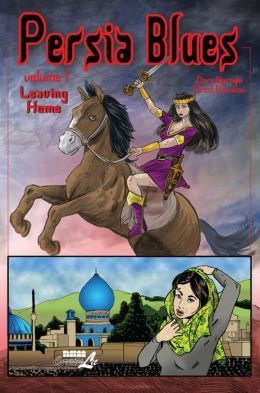By the time I reached the little gray box reading "End of Book 1" in the last panel of Dara Naraghi and Brent Bowman's Persia Blues, Vol. 1 Leaving Home, I still wasn't entirely sure what was going on, but, to the creators' credit, they had conjured the good kind of uncertainty — a sense of engaging suspense, with clues strewn throughout the pages, rather than a confusion borne of bad storytelling or uninteresting characters and subjects.
Here's what I do know: Persia Blues is the story of a young woman, or two versions of the same young woman, Minoo Shirazi.
One Minoo is a fearless swordswoman and adventurer thieving and fighting her way through the Persian Empire, aided by a mysterious fire power and her cautious, adventure-adverse lover, a scholar named Tyler. This Minoo's culture isn't just Zoroastrianism, but its god and devil figures Ahura Mazda and Ahriman walk among human beings, as do mythological creatures.
The other Minoo is a college student making her way through modern-day Iran, her only companion her liberal but protective college-professor father, who's been struggling for years to change his country's repressive culture from within, while his family has longed to escape it for a better life.
Both set out on very different quests by book's end; the ancient Minoo to the capital Persepolis at the words of a dying priest to play a role in the battle against Ahriman, the modern Minoo to graduate school in the United States.
As for their relationship, the modern Minoo delighted in adventure stories as a little girl, and her father is a professor of history, trying to preserve Persian culture from the ruling class trying to "Islamicize" portions of it away with religious propaganda. Is modern Minoo dreaming of ancient Minoo? Does one become the other? Are Naraghi and Bowman merely dramatizing the tension of a daily identity crisis in a place like Iran in the 21st century by literalizing it?
I didn't find myself overly concerned with those questions, because both sections were so well done and so fun to read. Bowman's fantasy world bears greater detail than his "real" world, with a great deal more shading, more lines and grayscale applied even to the word balloons; it's a darker place, but it's also a richer, deeper place, a black-and-white version of a fantasy novel cover.
Its modern Iran is more open, airier and lighter, with no grays, just the stark black of the ink on the white of the pages. It's a nice, visual signifier of the changes in settings, of course, but it also rather subversively makes the real world seem less real, with fewer textures and more shallow spaces.
Whatever the ultimate relationship between the two Minoos and her two worlds ends up being, the genre stuff sure flavors the personal drama, so that a conflict with the morality police overly an improperly pinned hijab follows a deadly hand-to-hand combat with brigands, and a fight with a pride of possessed lions or an army of scorpion men comes between discussions of whether there's any future for a female artist in modern Iran or what the neighbors might think if they see Minoo in the company of a young man.
Both storylines are engaging and well-executed, but the broad appeal of sword fights, magic and monsters is almost always a welcome addition to a comic book, even that half seems so much less relevant than the story of a young woman trying to be a young woman in a country where that can seem almost impossible, a country always in the news now, and, like so much of the region around it, perhaps poised for a massive, generational change.
The book began as a Kickstarter, crowd-funded endeavor, and has been serialized digitally, but its now finally available in a graphic novel format from NBM Publishing, which is how I first encountered and read it, because despite having shared a hometown with Naraghi and Bowman for about 10 years — the same town that Minoo is headed to for grad school in the story, by the way — and always wanting to support the local (or, in my case, the formerly local) scene, I am old-fashioned and prefer to read my comics on paper.
Fellow Robot 6 contributor Brigid Alverson interviewed Naraghi about the book in December, so if you'd like to read more about its genesis, you can check out the article. Now that it's out in bookshelf-ready format, I'm just here to let you know if it's any good or not. And it's good -- it's very good.




